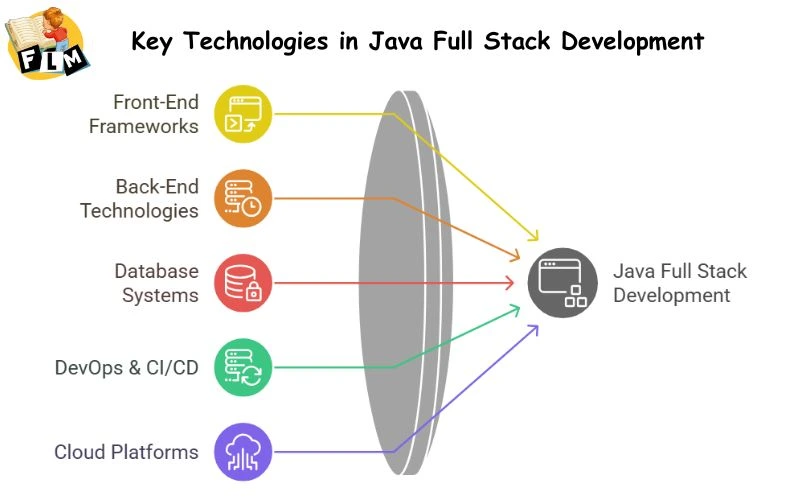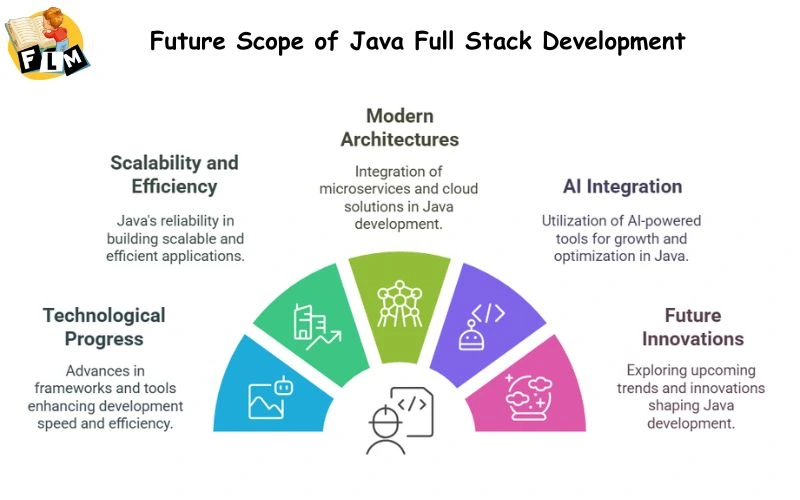Java Development Trends are shaping the future of Java full stack development, which are inspired by progress in technologies, frameworks and industry demands. As companies seek scalable, skilled and secure applications, Java remains a top option for full-stack development. Modern structures and tools continue to increase the speed and performance of development, making Java more powerful than ever. This guide examines the latest Java Development Trends in 2025, which highlights major innovations and best practices. It is necessary to stay updated with these trends, take advantage of Java’s full potential in full-stack development.
What is Java Full Stack Development?
Java Full Stack Development refers to the process of building both front-end and back-end of web applications using Java-based technologies. Java full stack developer works on UI/UX, server-side logic, database management and API integration.
Key Technologies in Java Full Stack Development

- Front-End: Angular, React, Vue.js
- Back-End: Spring Boot, Hibernate, Java EE
- Databases: MySQL, PostgreSQL, MongoDB
- DevOps & CI/CD: Docker, Kubernetes, Jenkins
- Cloud Platforms: AWS, Google Cloud, Azure
Current Trends in Java Full Stack Development
Rise of Microservices Architecture
Microservices architecture breaks large applications into small, manageable services. It increases scalability, security and maintainability.
Used technologies:
- Spring Boot
- Spring Cloud
- Kubernetes and Docker
Microservices also promote independent growth and deployment, allowing teams to work on separate services without affecting the entire application. This trend is becoming required for large -scale enterprise applications that require frequent updates and improvements.
Increased Adoption of Cloud-Native Development
Businesses are going into cloud-based solutions for better performance and cost efficiency.
Popular Cloud Services:
- AWS Lambda (Serverless Java)
- Google Cloud Functions
- Azure Kubernetes Service
Cloud-native applications enable auto-scaling, flexibility and low infrastructure costs. With cloud services offering flexible pricing models, businesses can optimize costs based on usage, making cloud adoption a major trend.
Integration of AI and Machine Learning
AI-Powered Applications improve user Experience, automation and decision making.
Common AI Library for Java:
- Deep Java Library (DJL)
- TensorFlow for Java
- Apache OpenNLP
From chatbot to recommended engine. AI is being used to enhance customer engagement in Java Full-Stack Applications and to streamline business operations
Full Adoption of Reactive Programming
Modern applications require high performance and scalability, giving reactive programming a significant trend.
Used technologies:
- Spring WebFlux
- Project Reactor
- RxJava
Reactive programming ensures efficient handling of the asynchronous operation, which is important for real -time applications such as chat apps and stock market platforms.
API-First Development
API-first development enables spontaneous communication between various applications and services.
Main Tools and Framework:
- Swagger/OpenAPI
- GraphQL with Java
- Restful API with Spring Boot
Along with adopting microservices and cloud, having a well -structured API is essential for interpreting and efficient software architecture.
Adoption of Low-Code and No-Code Development
Low-codes/no-code platforms help accelerate growth and reduce manual coding efforts.
Popular Java-based low-code platform:
- OutSystems
- Mendix
- Appian
These platforms allow businesses to create applications with minimal coding, making rapid software delivery enabled development to make growth more accessible to non-technical users.
Progressive Web Apps (PWA) with Java Full Stack
PWAS user offers rapid performance and offline capabilities while improving experience.
Java technologies for PWAs:
- Spring Boot with Reaction/Angular
- Workbox.JS for Service Workers
- Firebase for push notifications
PWAS reduces dependence on indigenous mobile applications, making web-based apps more powerful and user friendly.
Adoption of Serverless Java Development
Serverless architecture reduces the management of infrastructure and dynamically reduces scales depending on demand.
Popular Serverless Platform:
Serverless Java development reduces operational overhead and enables businesses to focus on the application logic rather than server management.
Evolution of DevOps and CI/CD in Java Full Stack
Continuous integration and Deployment (CI/CD) signs software release cycles.
Best CI/CD Equipment for Java:
- Jenkins
- GitHub actions
- GitLab CI/CD
With CI/CD pipelines, teams can automate testing and deployment, reduce human errors and improve software quality.
Growth of Edge Computing in Java Applications
Edge computing allows real -time data processing to reduce delay and improve speed.
Technologies supporting Edge Computing:
- Spring boot with IOT
- Apache kafka for real time data streaming
- AWS Greengrass
It is particularly beneficial for applications in industries such as healthcare, finance and IOT where real -time processing is important.
Evolution of Blockchain Integration with Java
Blockchain technology is being adopted for rapidly safe transactions and decentralized applications (DApps).
Java Framework for Blockchain:
- Hyperledger fabric
- Web3j for Ethereum Development
- Corda blockchain
Business is taking advantage of blockchain in Fintech, supply chain and safe identity verification applications.
Future Scope of Java Full Stack Development
 Java Full Stack Development is constantly developing, inspired by progress in technologies, framework and industry demands. As businesses prioritize scalability, efficiency and safety, Java is one of the most reliable options for full-stack development. Modern structures, libraries and tools are increasing the speed of development, optimizing to performance, and overall developers are improving experience. Additionally, cloud integration, microservices architecture and AI-Powered growth tools are further replacing Java Ecosystem. This guide examines the latest innovations that shape Java Full Stack Development in 2025, which helps developers and businesses to be ahead in the changing tech landscape. Maintaining these progress is important to take advantage of the full capacity of Java in building robust and future ready applications.
Java Full Stack Development is constantly developing, inspired by progress in technologies, framework and industry demands. As businesses prioritize scalability, efficiency and safety, Java is one of the most reliable options for full-stack development. Modern structures, libraries and tools are increasing the speed of development, optimizing to performance, and overall developers are improving experience. Additionally, cloud integration, microservices architecture and AI-Powered growth tools are further replacing Java Ecosystem. This guide examines the latest innovations that shape Java Full Stack Development in 2025, which helps developers and businesses to be ahead in the changing tech landscape. Maintaining these progress is important to take advantage of the full capacity of Java in building robust and future ready applications.
Essential Skills for Future Java Full Stack Developers:
- Java and spring boot proficiency
- Experience with modern front-end framework (React, Angular, Vue.js)
- Knowledge of microservices and cloud computing
- Understanding of DevSecOps and CI/CD pipelines
- Specialization in API Design and Integration
- Familiarity with AI/ML integration in applications
- Mastery of database management (SQL and NoSQL)
- Edge computing and understanding of IOT
- Experience on hands with blockchain for safety applications
Conclusion
The Java Full Stack development landscape is developing rapidly with new techniques, functioning and industry demands. The trends of Java development shape the future, making the developers necessary to stay updated. By placing these progresses, business and developers can create high performance, scalable and safe applications that meet modern requirements.
As companies shift to microservices, AI, cloud computing, blockchain and DevSecOps, Java full stack developers must continuously adapt and upskill to remain competitive. The rise of automation, containerization with Docker and Kubernetes, and serverless computing further enhances development efficiency.
Are you a Java full stack developer? Staying updated with these Java development Trends is important for the future proof of your career. Whether you are an experienced developer or simply start, mastering these cutting-edge technologies will unlock many career opportunities.
Suggested Articles:
-
Understanding the Full Java Tech Stack
-
What’s Next After Completing Your Java Full Stack Course
-
Local Resources for Java Developers in Telangana
Future-Proof Your Career with FLM’s AI-Powered Java Full Stack Development!
Java Full Stack Developer Training
Learn Java, Spring Boot, React.js, SQL, and AI automation to build powerful web applications. AI is transforming software development, and companies need skilled Java full stack developers who can integrate AI-driven solutions. This 5+ month live, interactive training will help you master real-world projects, automation tools, and industry best practices.
What You’ll Gain?
-
- High Demand – AI Skills Give You a Competitive Edge
- Earn ₹12 LPA+ with Java Full Stack & AI Expertise
- 100% Live, Expert-Led Training
- AI-Powered Development – Automate Coding & Debugging
- 7 Major & 7 Mini Real-World Projects for Hands-On Experience
- Mock Interviews, Resume Building & Career Guidance
- Exclusive: 2-Year Recording Access for the First 100 Enrollees
- Job-Ready Curriculum with Real-World Applications
Unlock your future with FLM’s AI-Powered Java Full Stack Development
Limited Seats Only– Enroll Now!
Visit: frontlinesedutech.com | Click Here to Enroll
WhatsApp: 8333077727

